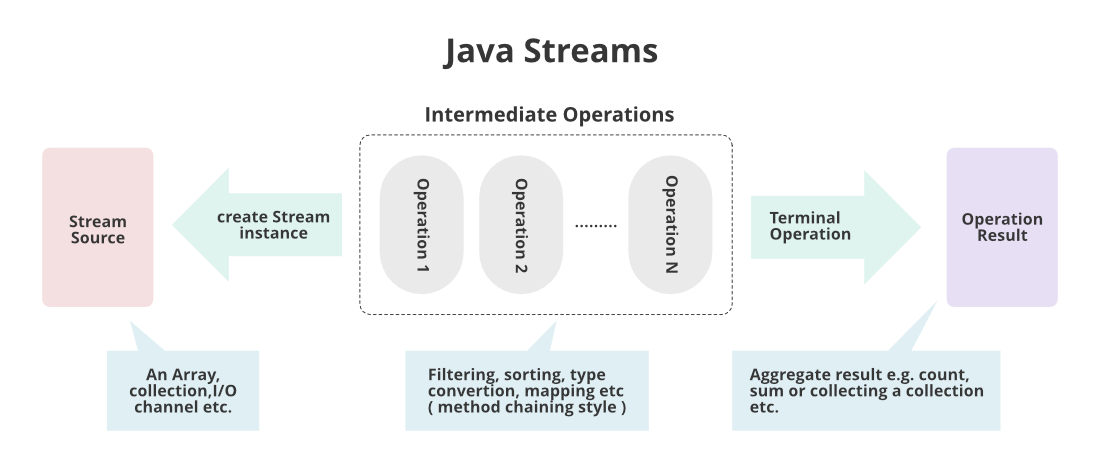Its called a stream because it is like a stream of water that continues to flow. Types of OutputStream are.
A In Depth Guide To Java 8 Stream Api Java2blog
Connection-oriented TCP sockets are implemented with the Socket classConnectionless UDP sockets use the Datagramsocket classA third type is the Multicastsocket class which is a subclass of the DatagramSocket classA multicast socket allows data to be sent to multiple recipients.

. Aggregate operations Stream supports aggregate operations like filter map. Java Collection Types also know as Collection framework provides many interfaces and classes that will help to implement reusable collection data structures. Erans answer described the differences between the two-arg and three-arg versions of reduce in that the former reduces Stream to T whereas the latter reduces Stream to UHowever it didnt actually explain the need for the additional combiner function when reducing Stream to U.
Lastly it explains the two types of intermediate operations stateful and stateless. The object stream classes are ObjectInputStream and ObjectOutputStream. Depending upon the data a stream holds it can be classified into.
Byte Streams and Character Streams. These classes implement ObjectInput and ObjectOutput which are subinterfaces of DataInput and DataOutput. It is suitable for any kind of file however not quite appropriate for text files.
Therefore a byte stream is different from a character stream. Sequence of elements A stream provides a set of elements of specific type in a sequential manner. In Java Character Streams are also classified into the following two types.
They are basically of two types. Introduced in Java 8 the Stream API is used to process collections of objects. Byte Streams Byte stream is used to input and output.
Stream Returns a sequential stream considering collection as its source. So an object stream can contain a mixture of primitive and object values. These collection types provide an architecture to store and provide manipulation for a group of objects.
In these types the most important and mostly used. FlatMap method takes as input an instance of Function named mapper which converts the type of elements in the stream from the current type T to another stream of type R It returns as output a stream of type R which is actually a flattened stream containing the elements in all the streams of type R obtained when mapper is applied on the input streams. Source Stream takes Collections Arrays or IO resources as input source.
ParallelStream Returns a parallel Stream considering collection as its source. Intermediate Stream Operations in Java. A stream is not a data structure instead it takes input from the Collections Arrays or IO channels.
Output Stream Output stream represent a destination source. Stream In Java. Character Streams are faster than Byte Streams.
That means that all the primitive data IO methods covered in Data Streams are also implemented in object streams. One of the design principles of the Streams API is that the API shouldnt differ between. Byte Stream Character Stream.
Types of Stream Stream is basically divided into following types based on data flow direction. All these streams are attached with the console. Java provides three different types of sockets.
Types of Character Streams. Terminal Stream Operations in Java. Structure of Java 8 Stream Operations Any operation involving the use of Java 8 Streams API has to have three important components to make it.
Java IO Stream Byte Stream. In these types the most important and mostly used type is FileInputStream. It provides a convenient means for handling input and output of characters.
With Java 8 Collection interface has two methods to generate a Stream. Reader Character Stream in Java. As an example of Java-based.
It is basically used to send outwrite the data to destination. So Java defines two types of streams. What are the primary streams in Java.
Input stream when the stream acts as a source of data for the logic unit. Java programs use byte streams to perform input and output of 8-bit bytes. Next it explains how the lazy execution of Stream operations allows efficient and optimized execution of Streams.
A byte stream access the file byte by byte. Output stream when the stream acts as. In Java 3 streams are created for us automatically.
A character-oriented stream or a byte-oriented stream and may be connected to a variety of sources or destinations. For example a stream might be aninput character-oriented processing stream. In the rest of the tutorial you will see the most common stream operations in Java.
Object combined Streamconcat Arraysstream first Arraysstream secondtoArray. Java InputOutput FileOutputStream FileInputStream BufferedOutputStream BufferedInputStream SequenceInputStream ByteArrayOutputStream ByteArrayInputStream DataOutputStream DataInputStream Java FilterOutputStream Java FilterInputStream Java ObjectStream Java ObjectStreamField Console FilePermission Writer Reader FileWriter FileReader BufferedWriter. Streams offer an effective way to iterate over several different types of collections.
To combine arrays using a Stream we can use this code. Comparison-based Stream operations in Java. It provides a convenient means for handling input and output of byte.
Input Stream Input stream is represented as an input source. Min and Max Operation. It is used to read the binary data from the source.
The reader is the super most class of all classes which are used for performing reading operations from any input device char by char. There are many types of streams. To get started with streams head over to the Java 8 Stream API Tutorial.
A stream is a sequence of objects that supports various methods which can be pipelined to produce the desired result. Types of InputStream are.


0 Comments